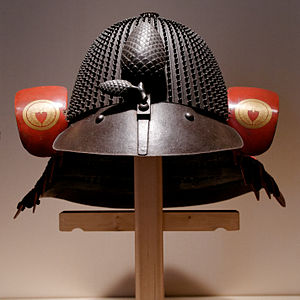Koboshi Bashi Kabuto
| Koboshi Bashi Kabuto | |
|---|---|

|
|
| Information | |
| Weapon type: | Protective weapon |
| Designations: | Koboshi Bashi Kabuto |
| Use: | helmet |
| Region of origin / author: |
Japan , armory |
| Distribution: | Japan |
| Lists on the subject | |
The Koboshi Bashi Kabuto is a helmet that was worn by Japanese samurai with their armor ( yoroi ).
description
The Koboshi Bashi Kabuto is made of iron . It is one of the multi-plate helmets, its helmet shell is formed from up to 120 pie-shaped pieces. There are two other variants of the helmet, the Suji Bashi Kabuto and the Hari Bashi Kabuto , which differ slightly. In contrast to the other variants, the individual panels here are equipped with ribs or ridges on the panel edges and provided with a large number of rivets with large, slightly elongated heads. These rivets are used to attach the decoration and offer additional protection against sword blows, as the force of a blow is weakened by the rivets. A type of button ( Japanese: Tehen-No-Kanamono ) is attached to the top of the Kabuto , which is used to attach the plates.
The additional decoration of the helmets can vary greatly. In general, a side protection (Fukigaeshi ), a neck protection (Shikoro), a helmet ornament ( Maedate ) and a fastening strap (Shinobi-O-Noh) are used on the helmets to fix the helmet on the head. Face masks ( Menpo ) were often worn with this type of helmet . The helmets were often painted in different colors, this served for decoration, but also to protect the metal of the helmet from the weather .
literature
- Ian Bottomley: Japanese armor. The Galeno Collection. Stone Bridge Press, Berkeley CA 1998, ISBN 1-88065-636-1 .
Individual evidence
- ^ Ian Bottomley, Anthony Hopson: Arms and Armor of the Samurai. The History of Weaponry in Ancient Japan. Crescent Books, New York NY 1994, ISBN 0-517-10318-4 , p. 100.